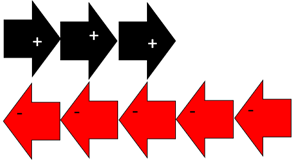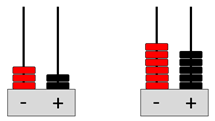Purpose
The purpose of this activity is to support students to understand that integers are often used to represent a state of balance.
Achievement Objectives
NA4-6: Know the relative size and place value structure of positive and negative integers and decimals to three places.
Required Resource Materials
- Copymaster (integer cards)
- Dice
- Skipping rope or chalk (optional)
Activity
- Lay out these three sets of integer cards:

What is the same about these three collections of integer cards?
Students should note that there is a balanced number of positive and negative cards in each collection. - Draw an empty number line with chalk or use a skipping rope. Act out the movements associated with the cards, one unit right (forward) for positives and one step left (backwards) for negatives.
The idea is for students to understand positive and negative numbers as having direction and length.
Students should notice that when positives and negatives are balanced then the endpoint of the journey is always zero. You might record the results as additions.- +1 + -1 = 0
- +2 + -2 = 0
- +3 + -3 = 0
- Ask students to give some other additions that equal zero.
Students should give balanced equations. - Write -777 + +777 = 0, +777 + +777 = 0 and -777 + -777 = 0.
Are these equations true?
Do students recognise that only the first equation is true? Can they find the correct answers for the second and third equations? - Use two dice of different colours, preferably black and red, to generate different numbers of positive and negative numbers. Alternatively, use different coloured pens on a blank dice. Roll both dice and make the positive and negative amounts that occur. For example, if the black number is 3 and the red number is 5 make this collection of cards.

If we act out this collection starting at zero, where will we end up on the number line? - Act out the movements of 3 steps forward and 5 steps back to end at -2.

Will it make a difference which order we use the cards?
How can we record combining positive three and negative five?
Use both +3 + -5 = -2 and -5 + +3 = -2 to show that the order of addends does not affect the sum. - Pose similar problems or let students investigate using their own pair of dice.
Next steps
- Pose open problems where the students are given the sum, such as -1, and asked to create collections of positive and negative cards to match that sum. Students might make a poster showing various ways to sum to a given number.
- Use a two-pronged abacus to represent states of balance between positives and negatives.
Use a black disc to represent positive one and a red disc to represent negative one. The model is very helpful to contexts such as money (dollars and debts). For example, here are two examples of a balance of -1.
Add to plan
Level Four